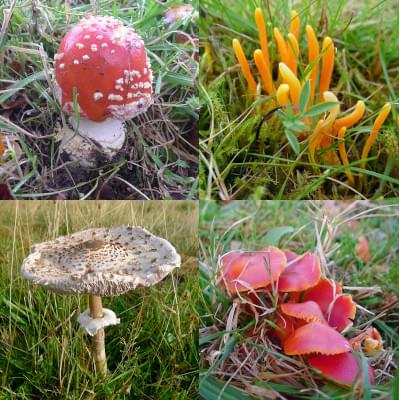Ecology
Fungi you may see on Pipe Green
Ecology
Fungi you may see on Pipe Green
Fungi
Pipe Green supports a range of different fungi, from the large parasol mushrooms, as big as dinner plates, to the small, yet beautifully formed waxcaps, that nestle in amongst the grass. Whilst many of the fungi are those you would expect to find on grassland, a number grow on the cattle dung and others have a symbiotic relationship with some of the trees (e.g fly agaric and silver birch). However, from a conservation viewpoint, it is the waxcaps (and associated species) that are the most important and they form a habitat known as a waxcap grassland. Unfortunately the UK has lost much of this habitat due to modern agricultural methods, so it is important that we conserve and protect these waxcap grasslands.
Just to warn you, I am no expert on fungi, so whilst I have tried to identify some of the fungi, they may not be correct - please let me know if you know otherwise!

Waxcap fungi
A waxcap grassland, usually contains four very different types of fungi (known collectively as CHEG species) and I am glad to say that all four types grow on the Green and can be seen in late Autumn. The CHEG species like low nutrient ground, short grass and plenty of moss and fortunately, due to the way we manage the Green (no fertilisers, grazing cattle etc), such conditions are present and allow the CHEG species to thrive. For more details click on the button below.
Other Fungi
Apart from the waxcap species, there are a number of other fungi that can be found growing on the meadow, which all vary in shape, size and colour with some being a lot more obvious than others! Intriguingly some of the fungi grow on the dung left by the cattle, which in turn emphasises the importance of having the Green grazed - it is not just the plants that benefit! For more details click on the button below.